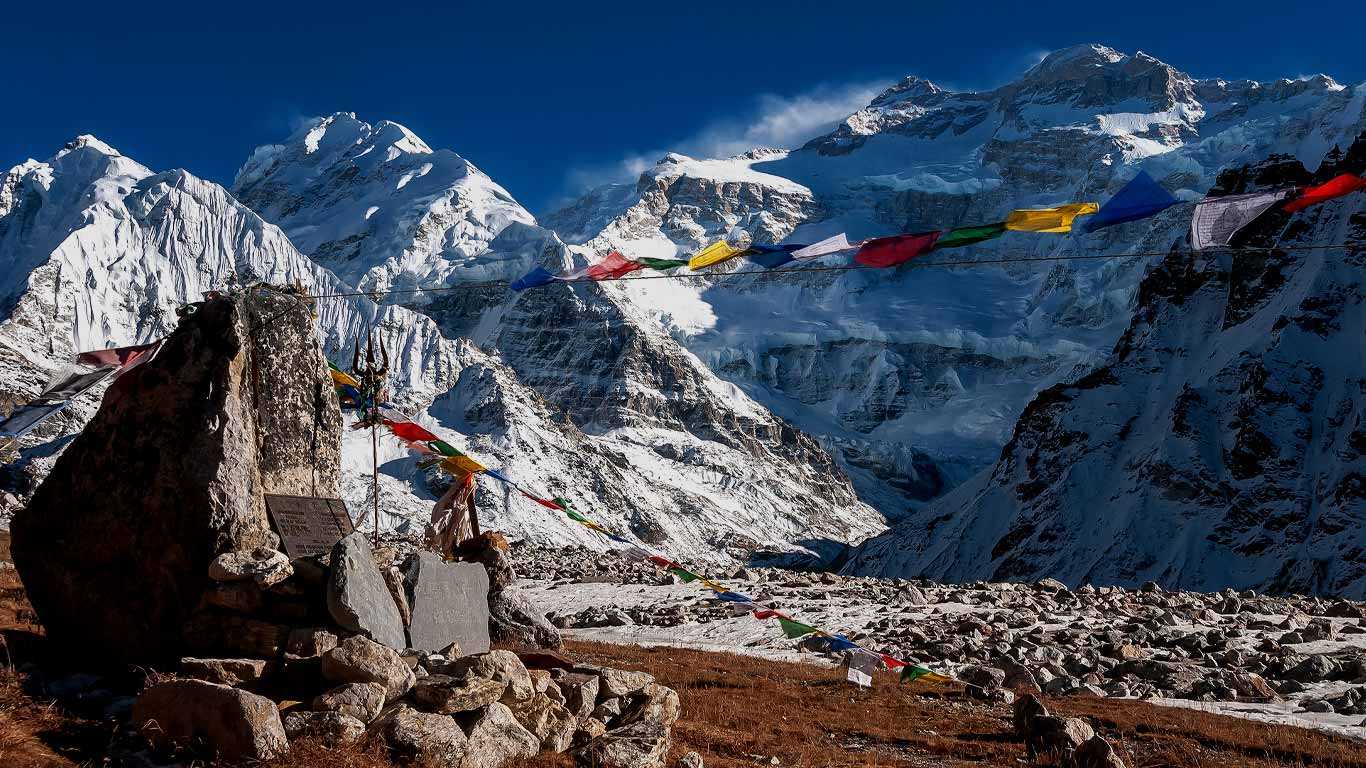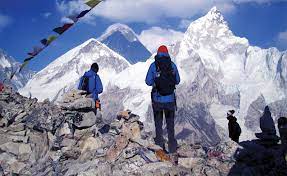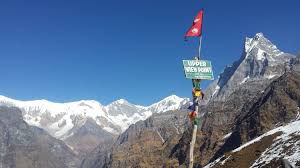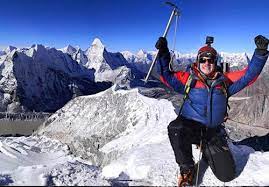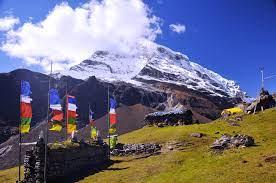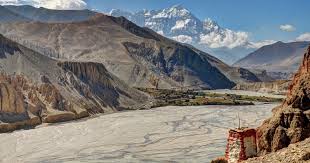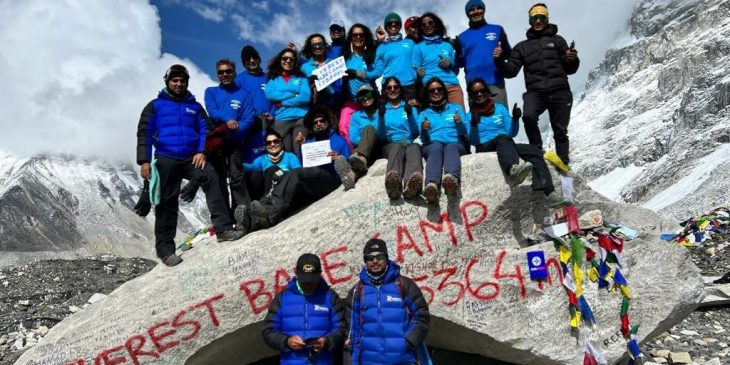- Call Us +977-9841628594 | 01-4249517
- Enquiry Now
Kanchenjunga Circuit Trekking
Trekking both north and south base camps of world’s 3rd highest peaks .
 No-shopping | Group Tour
No-shopping | Group Tour

Overview
Kanchenjunga Circuit Trekking with Eco-Himalaya leads you to explore both base camps of the world’s 3rd highest Mt. Kanchenjunga.Mt. Kanchenjunga straddles the border between Nepal and Sikkim the northeast states of India. The most popular and widely visited is from the Nepal side of the Far Eastern Himalayas. Due to its remote location where flights and drives are involved, as well as one of the longest treks.Mt. Kanchenjunga stands high at 8,586 m and 28,169 feet the mountain was first conquered by the British Expedition.Climbing from the South Base Camp route on May 25th, 1955, since then Mt. Kanchenjunga is often climbed.Kanchenjunga Circuit Trekking of 3 weeks duration, one of the longest epic journeys around Nepal Himalayas. As well a great opportunity to explore both South & North Base Camps of the same mountain in one trek.The charm of Kanchenjunga Circuit Trekking, is its tranquil and pristine wilderness, walking on off the beaten tracks. Away from the main flow of trekkers, towns, and human settlements for some days, where walk follows in serene surroundings. Covered in dense vegetation and a lovely forest lined with tall rhododendron, oaks, pine, and fir trees.
An amazing walk from the green forest and towards arid and barren terrain within remorseless fields of ice and glaciers.Kanchenjunga Circuit allows visitors to enjoy varied changes in scenic landscapes, temperatures, and vegetation with local cultures.The walk leads from mid-hills around heavily farmed terraces to remote isolated areas, facing views of massif Mt. Kanchenjunga range.Kanchenjunga Circuit Trekking begins with a sweeping scenic short flight from Kathmandu to land in low warm areas of Eastern Nepal.From the town of Bhadrapur, an exciting drive leads to the mid-hills of Ilam famous for tea and its vast tea gardens. Then reach the start and end point of the trek at Taplejung and Sukhetar, where the walk commences heading north east.
An enjoyable pleasant trek to start with through several farm villages with short down and ups, crossing streams. As the trek progresses enter a lovely dense forest, then reach our first major destination at Tseram.A small isolated spot where a day hike takes you to Oakthang near Kanchenjunga South Face with Yarlung glaciers. Enjoy the dramatic views of surrounding giant peaks with the massive south face of Mt. Kanchenjunga.The adventure continues by crossing three passes over Mirgin-La, Tamo-La, and Selele-La passing above 3,500 to 4,250 m high. Every hard effort rewards with outstanding views of surrounding high snow-capped peaks and then reaching other sides of Kanchenjunga.
Reaching Ghunsa a lovely village with neat farmland and pasture fields for grazing yaks. From Ghunsa walk heads north leaving the tree lines and vegetation for sheer mountain wilderness.The climb leads to Lhonak a cattle herder settlement and then walks high to Pang-Pema around Kanchenjunga North Base Camp.
Enjoy the stunning amazing scenery of massive Kanchenjunga with Kabru and Janu Himal, facing remorseless fields of ice and glaciers.On completing all our endeavors covering the main highlights, return journey to Ghunsa, and then on an alternative route. Where walk leads to lower areas and nice farm villages of Gyapla Phedi Sekathum and Japantar to Chirwa. Then finally walk ends on reaching Taplejung town and Sukhetar for an interesting drive to lively Ilam Bazaar.From Ilam Bazaar a scenic drive to low warm areas of Terai reaching Bhadrapur airport for a scenic flight to Kathmandu.On arrival at Kathmandu, our wonderful adventure concludes, after a great memory and wonderful experience on Kanchenjunga Circuit Trekking.
Itinerary
Day 1Arrival in Kathmandu and transfer to hotel.
On first arrival at Kathmandu and Nepal International Airport received by our guide and staff with traditional greetings. Taking care of your baggage, and then a short drive to the hotel, located in the heart of a city near the exciting areas at Thamel. Check into your lovely rooms, after getting refreshed from the Jet-Lag, join in with other members for group briefing. Provided by your guide or Group Leader, offering information regarding the trek, hotels, local lodge. As well of local culture with do’s and don’ts, evening a group welcome dinner in a nice authentic Nepali Restaurants. Entertains the environment with folk cultural program as introduction to Nepalese heritage and culture.
Day 2Tour of Kathmandu heritage sites of great interest.
Morning after breakfast, at given time our city and cultural guide receives you at the hotel. A short drive to the hub of Kathmandu city, for exciting tour of old Durbar Square / Palace Courtyard. The area is teemed with life and activities, a great way to soak into Nepalese cultures. Visiting historical and religious monuments listed in UNESCO World Heritage Sites most of the ancient buildings.After an interesting time at Durbar Square, a short drive to Nepal’s most important landmark, the Swayambhunath Stupa of more than 2,600 years old history. A Buddhist monument tucked on a hill top west of the city, from here visit the Hindu holy temple of Pashupatinath. The tour continues to large dome Stupa of Bouddhanath, as well known as ‘Little Tibet’. A great place to enjoy the tour of the world’s largest Stupa with all seeing eyes of Lord Buddha.Enjoying the day tour, transfer back to hotel rest of the afternoon preparation for the trekking and packing the right gear.
Day 3Fly Kathmandu to Bhadrapur drive to Phidim 1,340 m.
Morning as time for short flight to Bhadrapur, transfer to Kathmandu domestic airport. After checking in board in a big aircraft for sweeping panoramic flight of 40 minutes. During air borne enjoy marvelous views of Langtang, Jugal Himal with Gaurishankar and Mt. Everest. As plane heads further east views of Mt. Makalu and Kanchenjunga, and then land at Bhadrapur airport.A warm low areas, located on Nepal Far Eastern Terai Belt, from the airport at Bhadrapur with time for refreshment. Meeting trekking staff, guide and porters an exciting drive takes you up to cooler hills. Heading past Ilam town and its vast Tea-Garden, the drive continues through farm villages. Then ending the exciting drive reaching Phidim, a small town amidst wide tea-garden, overnight halt in a simple lodge.
Day 4Drive to Suketar 2,440 m, trek to Lali Kharka 1,900 m. 4 hour drive and 3 hour treks.
Start the morning from Phidim town, taking another exciting drive on a hilly rough road to Suketar. Located in Taplejung district of Kanchenjunga region, having time to get organized. Then getting ready for adventurous walks on winding and undulating path through farm areas. The walk leads down to a forested area on a gentle path reaching Lali Kharka for an overnight stop. Lali Kharka a small nice farm village facing view of Mt. Kanchenjunga towards north. The camp is set on a farm field close to the village or stay in the comfort of simple lodge.
Day 5Trek from Kande Bhanjyang 2,100 m -06 hrs.
After a nice morning, start the heading downhill past several farm villages, inhabited by Hindu hill tribes. A mixture of Brahmins, Chettries and Kirat people known as Rai and Limbu, as walk continues to Tembawa. Having refreshing break, continue walk on a long descent to Pokora village. Then cross over a suspension bridge, as climb leads to steep uphill to a place called Kunjari. From Kunjari few hour trek to Kande Bhanjyang for overnight stop either in tented camp. An options staying in a small simple guest house, this is a lovely small farm village. Enjoy grand views of Kanchenjunga and Yalungkang peaks, with surroundings beautiful landscape scenery.
Day 6Trek to Phompe Danda 1,850 m -06 hrs.
From Kande Bhanjyang, morning starts with steep downhill walk through terraced fields of rice and millets. Soon the trail follows into a dense forested areas leading to Nandeva Khola / stream. Crossing the stream, and then climb to a high hill covered in forest, as walk follows to Loppoding village. From here onward with ups and down-hill reaching Fun Fun, a place having a resting spot. Enjoy another exciting views of Khumbakarna, Yalung and Kanchenjunga peaks, the trek continues downhill towards Yangpang. A small farm area and then climb for an hour to Pompe Dhada for overnight halt. Situated atop a high crest facing views of Mt. Jannu, overnight tented camp is set at Phompe Danda.
Day 7Trek to Yangphudin 2,150 m at Sherpa Gaon - 06 hrs.
Start the morning walking on a winding path and downhill to Khesewa Khola, cross a suspension bridge. As walk follows with short climb to Mamankhe village. Having stop for lunch, afternoon leads to short uphill, and skirting the ridge on a level path to Dekadin village. From here walk to Kabeli Khola as trail leads to gentle up and down, crossing several smaller streams. On leaving the river behind another uphill through farm fields, and then reaching Yamphudin for a short rest. As climb continues to overnight path reaching Sherpa Gaon, a moderate size farm village.This is the last permanent village and human habitation of Sherpa people the mountain tribes of eastern Himalayas. The campsite is set on a farm field near the village, next village is Ghunsa. After few days treks on the other sides Kanchenjunga south base camp.
Day 8Trek to Doronding 2,880 m via Lashe Tham-La -06 hrs.
From Sherpa Gaon, morning walk leads to Chitre, walk along Kabeli Khola, crossing a tributary of Omje Khola. As climb starts to a steep uphill reaching Dhupi Bhanjyang, a high grass ridge top. The area is also called as Lahse Tham, from here walk downhill into a deciduous forest to Omje Khola. Having a short stop, a steep climb into rhododendron forest and then end the day. Finally reaching Doronding after walking past Chitre, at Doronding for overnight in a tented camp.
Day 9Trek to Tseram 3,770 m - 05 hrs.
A lovely morning with pleasant overnight in a tranquil surrounding, from here walk leads closer to our first destination. Adventure towards Kanchenjunga South Base Camp on route Tseram, as morning walk leads to Ramite Bhanjyang. From here a steep climb for few hours through magnolias, rhododendron and bamboo forest to Ramite.An isolated spot with a single small stone hut, from here climb to a ridge reaching a small pond. Walk continues to a valley covered in dense tall pine and rhododendron trees, and then walk to Wahta.Located in complete isolation with a small hut and a shrine, close to a huge boulder shaped like a serpent. From here a short walk to Tseram for overnight camp close to roofless caves. Enjoy views of terminal moraine fed from Yalung glacier includes peaks of Kabru 7,353 m, and Talung 7,349 m.
Day 10At Tseram for hike to Oktang near Kanchenjunga South BC.
Trekking for near to week, certainly a deserving rest day but for interested people can enjoy a day. An exciting hike to Oktang near Kanchenjunga South Base Camp, which is the original early base camp. Where first British Expedition climbed to the summit of
Mt. Kanchenjunga from the south route.The hike leads to Yalung Glacier and around the south wall of massif Mt. Kanchenjunga. Includes grand views of Talung and Kabru peaks, after an exciting visit to Oktang near South Base Camp.Head back to Tserem for overnight stop, after a long interesting and adventurous to Kanchenjunga South Base Camp.
Day 11Cross Sele-La Pass 4,250 m and camp at 3,700 m - 08 hrs.
From Tseram after visiting the first highlight of the adventure to south base camp. Morning walk to Yalungbar with steep up, crossing a river and then back into forest. The trail follows to a steep climb for an hour and then reaching a small ponds. From here adventure leads to cross over three passes smaller passes of Mirgin-La, Tamo-La and Selele-La.Climb for an hour to the top of Mirgin-La overlooking views of Kabru and Kanchenjunga range of peaks. As walk continues downhill and then up to Tamo-La, and continue descent with climb to the last pass.Crossing over Sele-La at 4,250 m high, enjoy the magnificent panorama of Makalu, Baruntse, and Chamlang Himal. A slow downhill leads to the base of the pass for overnight stop.
Day 12Trek to Ghunsa 3,480 m - 04 hrs.
Starting the morning walk to a steep descent for an hour through dense forest of rhododendron and pines. Then following on a winding to Ghunsa River, crossing the river on a small bridge. As walk leads the northern side of Kanchenjunga at Ghunsa village for overnight.A nice neat traditional mountain village inhabited by Sherpa and Bhotia people the highlanders of strong Tibetan origin. The houses built of stones and fine woods, having a neat and tidy small farm land.Explore the village adorned with Buddhist religious monuments and prayer walls, overnights either in camp or stay in a lodge.
Day 13Trek to Khambachen 4,000 m-06 hrs.
After an enjoyable overnight in Ghunsa, adventure continues towards our last major destination to Kanchenjunga North base camp.
The trail follows to a river facing views of waterfalls, coming across Yak herder temporary camps. As walk enters rhododendron and pine forest wit climb up to Rambuk Kharka, and then cross a small glacial landslide. The walk with scenic views of Khumbukarna and Janu Himal with array of snow peaks. Soon leaving tree lines behind, heading into an arid terrain reaching Khambachen for overnight halt.The camp set on a scenic valley facing majestic views of Sharphu peak rises above 7,070 m. Includes views of Mt. Janu and Wedge peaks.
Day 14Trek to Lhonak 4,780 m - 06 hrs.
Morning adventure leads above a river for an hour and then heading further east. Walk downhill to a river, and then climb over rocks and boulders heading to a terminal moraine of Kanchenjunga glacier.After leaving Ramtang Kharka, which is a Yak herder summer camp, as trail comes across Kanchenjunga glacier. An exciting walk crossing to the junction of Lhonak and Kanchenjunga glacier, then reaching Lhonak for two overnight stops.From Lhonak enjoy superb views of Mera, Nepal Peak and Wedge Peak a great wild country enclosed by high peaks.
Day 15At Lhonak hike to Pang Pema 5,150 m / 16, 896 feet around Kanchenjunga North Base Camp- 07 hours both ways.
Finally towards our major goal and highlight of the adventure, morning an exciting hike to Pang Pema. Where Kanchenjunga North Base Camp located, as well the highest point of the adventure.
Day 16Trek to Ghunsa 3,480 m - 08 hours.
After a great tough walk to Pang-Pema and North Kanchenjunga Base Camp. Walk back on the same trail past Kambachen to Ghunsa enjoying a long day trek.
Day 17Trek to Gyapla Phedi 2,300 m - 07 hours.
From Ghunsa route leads on an alternative trail, an opportunity to experience both sides of Kanchenjunga beautiful country.The walk continues facing views of snow peaks past scattered cattle herder summer camps to Gyapla Phedi for overnight stop.
Day 18Trek to Sekathum / Japantar 1,350 m - 07 hrs.
After a pleasant overnight at Gyapla Phedi, morning walk heads down to low warm farm areas. Walking back around the mid-hills and farm villages to reach Sekathum and near Japantar for overnight stop.
Day 19Trek to Chirwa 1,250 m - 06 hrs.
An enjoyable walk as trail heads further lower areas within warm farm land. As trek progress walking past smaller villages encountering friendly villagers, trek continues coming across many scattered villages.Slowly the day comes to an end reaching Chirwa for overnight stop.
Day 20Trek to Phurumbu School 1,500 m -07 hours.
Morning walk downhill with few short climb and then back downhill heading towards lower hills of Kanchenjunga. As walk finally comes to an end reaching a small place to camp at Phurumbu village school premises.
Day 21Trek to Sukhetar 2,440 m -04 hrs.
Last day of the wonderful adventure to Sukhetar at Taplejung town, the walk follows through farm villages. Then heading towards the end of our trek at Sukhetar, a small town with an airstrip. The flight operates seldom, and unreliable to Kathmandu via Biratnagar city.Overnight in a simple guest-house or in a lodge, after completing the long walk of three weeks.
Day 22Drive to Ilam Bazaar overnight in local Lodge -06 hrs.
Morning after completing the long adventurous walks, taking an exciting drive to a nice little hill town to Ilam. A famous place for Tea and its Tea Garden, the flavor of the local tea much appreciated throughout Nepal and abroad.
Day 23Drive to Bhadrapur airport and fly back to Kathmandu.
Morning after breakfast, an exciting drive to low warm southern areas of Eastern Nepal. Reaching flatland of Terai belt at Bhadrapur airport for scenic short flight to Kathmandu. On arrival transfer to your hotel, rest of the day at leisure to relax after a long adventurous walk around Kanchenjunga Circuit Trekking.
Day 24Free day at leisure guided tour on request.
Enjoy the full free day in Kathmandu relaxing and recalling the memories of wonderful Kanchenjunga Circuit. One can join in for another exciting tour of adjoining cities of Patan / Lalitpur and Bhaktapur, or enjoy individual activities shopping souvenirs of Nepal.
Day 25Transfer to Airport for the International departure.
Your last day in Kathmandu and Nepal, as per your international flight time our staff transfer you to the airport. Then bid farewell to guide and staff as you enter the airport terminal for homeward bound flight, after a marvelous enjoyable adventure to Kanchenjunga Circuit Trekking.
Whats Included
Whats Excluded
Important News
Eco-Himalaya, do not fly straight to Sukhetar airport at Taplejung and back to Kathmandu. The flight to Sukhetar is not reliable and unpredictable, leads to delay and cancellation for several days.Due to unfavorable bad weather conditions and lack of passengers, this is why we have used flight to Bhadrapur airport. The flight operates all seasons of the year. Includes two days drive each ways to Sukhetar the start and ending point of the trek.
Our extension exciting trips:
Reviews
Booking
Place Location
Booking
Major Highlights
- Adventure to both north and south base camps of Mt. Kanchenjunga.
- Adventure to both north and south base camps of Mt. Kanchenjunga.
- Walk on tranquil trail away from main flow of trekkers and civilization.
- On the foot of world’s 3rd highest peaks enclosed by high mountains.
- Enchanting woodland of tall rhododendron, pines and fir tree lines.
Short Trek Profile
Trekking Mode
Tourist standard to *** Hotels in Kathmandu and best available lodges or tented camping.Trekking Grade
Moderate to Adventurous walks.Highest Spot
At Pang-Pema Mt. Kanchenjunga North Base Camp 5,150 m / 16, 896 feet high.Activities
Sightseeing tour, exciting flight and drives with scenic, cultural trek.Trek duration
20 Nights & 21 Days with flights and drives.Starting Point
From Sukhetar- Taplejung district.Ending Point
At Sukhetar and Ilam town.Trekking Routes
Sukhetar, Yangphudin, Tseram, Ghunsa-Lhonak- North base camp.Return Route
Ghunsa, Sekhathum, Chirwa to Tapleung-Ilam.Total Trip
24 Nights & 25 Days from arrival to departure.Best Seasons
The best seasons for Kanchenjunga Circuit Trekking are in spring and autumn/fall however one can visit nearly all year round, except for the wet monsoon time of July and August.The main flow and high season are spring starting from March to May, where days are longer with enough sun-light hours. Spring, is the perfect season when wildflowers are in seasonal bloom, especially the rhododendron of various species from tall trees to short bushes.Morning and late afternoon till night time is cold from 2,000 m above, chances of light rain and snow-fall sometimes.The next best season is autumn/fall, the high time for trekking around the Himalayas. Most days are crystal clear for scenic walks and best views, but short days due to sun-light hours. Can be much colder from late afternoon till the next morning before the sun hits the area. Chances of snowfall sometimes from above 2,500 m high.
What to Expect
Nepal is a country of the world’s highest mountain range known as the Himalayas, where 80 % of landscapes are covered by hills. As well as greater ridges and mountains, where one can expect walking ups and downhill.The only flat land of the country is located south, which extends from the Far East to the Far West of Nepal. The low land is known as the Terai belt, of sub-tropical climate, the country with most mid and high hills. The people around the hills, especially around eastern Nepal and from Ilam, Phidim, and Sukhetar around Taplejung district. Populated by Kirat Rai and Limbu, the main hill tribes of Eastern Nepal.As well as a few ethnic tribes Brahmin, Chettries, and Newar, including a few Gurung and Magar, people. Higher areas of Eastern Nepal are inhabited by Sherpa, Bhotia people of Tibetan origin the highlanders of Eastern Himalayas. The Sherpa and Bhotia of Kanchenjunga and Taplejung areas are interwoven with Buddhism religions of old heritage and culture. Which is similar to its Tibetan predecessors. Every house is adorned with prayer flags and villages have religious monuments and prayer walls.The hills are lined with beautiful forests lined with rhododendron, oaks, hemlocks, pines, and fir trees. Higher up with Juniper and Birch trees, but soon gives away for short bushes and shrubs within rocky and windswept terrains.
The other places after Lali-Kharka and Yangphudin on route to Tseram and Kanchenjunga South base camp are temporary settlements to cater to the needs of travelers with nice simple huts serving as lodges. On leaving Tseram towards Ghunsa with few overnights in tented camping due to lack of good lodges in some areas. Includes, full support of camping kitchen unit of cook, kitchen staff, guides, and porters to carry all the needful camping gear for the whole trekking.Nepal has more than 60 ethnic groups and 70 native spoken languages, with a blend of Hindu and Buddhism religions.
On this trek expect more uphill climbs with downhill walks, but with constant views of snow-capped peaks. Overlooking massif range of Kanchenjunga and Makalu with Jannu Himal.
Extension trips
People with enough time in Nepal, can join in for various adventure sports activities. Paragliding, Ultra-Light Flight, Bungee Jumping, Zip Flyer, White water or scenic float Rafting. Other extension program is Mountain Biking for few days, and trip to Chitwan National Park for Wild-Life Safari.
Detailed Itinerary:

